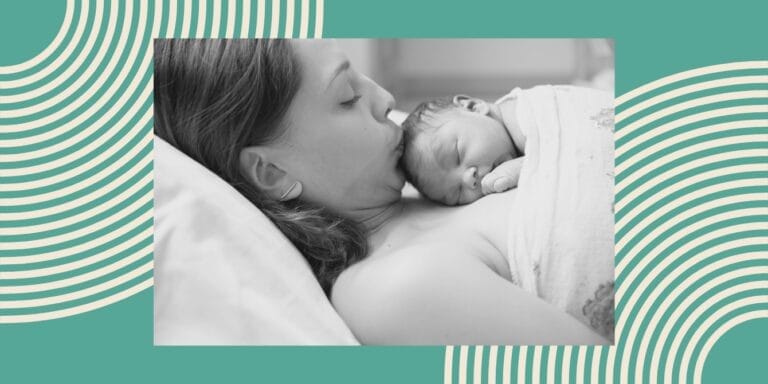Researchers find a chemical link that could help predict the risk of preterm birth

bbernard/Shutterstock
The existence of certain chemicals found in the vagina may be linked to a higher risk for preterm birth.
Table of Contents
In a 2023 study published in Nature Microbiology, researchers found a link between certain chemicals in cosmetic and hygiene products and a higher risk for preterm birth. The chemicals accumulate in the vagina and when broken down; they create substances that could affect fetal development.
While the gut microbiome gets a lot of attention for its role in health and disease, it’s not the only place bacteria like to call home. Your vaginal microbiome is crawling with billions of microorganisms that, when healthy, work together to protect your reproductive system.
But pregnancy puts pressure on an already fragile balance between good and bad microbes in the vaginal microbiome. Any changes that tip the scales towards an unhealthy environment can increase the risk of pregnancy complications, including preterm birth. One potential contributor to an unhealthy vaginal microbiome and preterm birth? Exposure to harmful toxins—some of which we can find right at home.
What causes preterm birth?
Fifteen million babies are born prematurely every year. Despite the large number, there is no obvious cause behind preterm birth. Rather, it seems there are multiple factors at play.
First there’s the genetic component. Scientists have previously identified six genes involved in determining the length of pregnancy and when a baby is born. Preterm births also seem to run in families. A 2020 study found women or female relatives within three generations born prematurely were more likely to deliver their babies early than women without this family history. Other research has suggested it’s the baby’s genes, not the mom’s, that causes preterm birth.
There are also multiple environmental factors that can increase the chance of a preterm birth. These include:
- Multiple pregnancies
- Infections
- Chronic conditions such as high blood pressure and diabetes
- Air pollution
- Age of the mother
Some environmental factors are preventable. For example, quitting smoking early in pregnancy can drop the risk for preterm birth by up to 20%. In the current study, the chemicals from personal care products accumulated over time. This suggests that stopping the use of products formulated with known chemical toxins could prevent bacterial changes that trigger early labor.
Related: 5 questions to ask at your first fertility appointment
Chemicals from personal care products increase risk of preterm birth
The study authors collected swab samples from the vaginas of 232 women in their second trimester of pregnancy. Of the 232, 80 women experienced preterm births.
Researchers focused their attention on the vaginal metabolome—a set of small molecules like metabolites produced by cells and bacteria living in the vaginal microenvironment.
“The metabolome can be seen as a functional readout of the ecosystem as a whole,” explains Tal Korem, PhD, an assistant professor in the program for mathematical genomics and the departments of systems biology and obstetrics and gynecology at Columbia University, in a press release. “Microbiome profiling can tell us who the microbes are; metabolomics gets us close to understanding what the microbes are doing.”
Related: Ara Katz wants kids to love their microbiomes
More than 700 different vaginal metabolites were identified from the 232 pregnant women. About 108 of the 700 metabolites were present in all women, regardless of delivery date. However, the study authors observed more metabolites among the 80 women who delivered early than women who carried to term.
Four metabolites were significantly linked to spontaneous preterm birth. Three of them—ethyl-beta glucoside, tartrate, diethanolamine (DEA)—were not created from existing vaginal microbes but from an outside source.
While the study did not find the specific source behind this group of metabolites, they note that most of these metabolites are listed in cosmetic and hygiene products. And despite coming from outside the body, the chemicals producing these metabolites were found in over 95% of women who had a preterm birth.
Related: PFAS exposure may significantly affect male fertility
How do these metabolites contribute to preterm birth?
One possible explanation the study authors propose is related to choline. All preterm births were linked to lower levels of choline, an essential nutrient for the growth and development of the fetus. Insufficient choline during pregnancy is associated with the short stature and immature organ development seen in preemies. The DEA metabolite has previously been shown to disrupt choline metabolism, contributing to low levels in the body.
Related: More choline during pregnancy boosts kids’ attention
Metabolites may be good biomarkers for predicting preterm birth risk
The team used machine learning models to create an algorithm that would measure levels of certain metabolites and predict the chances of preterm birth. The model was tested against two separate groups of women who eventually delivered preterm or had a full-term delivery. It was robustly accurate in predicting who would have preterm deliveries in the middle of their pregnancy. The model was also found to be more accurate than models that only collect data on the vaginal microbiome or on the mother’s age, BMI and birth history.
The algorithm is a good starting point for early diagnostics of preterm births. But don’t expect to find the tool in your doctor’s office anytime soon. The results are based on a small study of pregnant women, so the model is limited to detecting only the metabolites found in this cohort. It’s also possible there’s another metabolite not seen in this group that could be linked to spontaneous preterm birth. Additionally, it’s hard to generalize the results against other groups of women in different stages of pregnancy.
Related: The FDA is finally taking steps to limit lead in baby food
For now, your best bet is to decrease the amount of exposure you have against chemicals that trigger early delivery. For example, check if your beauty products have chemicals like DEA in their ingredient list. You might also want to consider avoiding a feminine hygiene product called douching, which is linked to preterm birth. If you’re unsure whether something you’re using could compromise your baby’s health, bring it to your next prenatal visit. They can tell you which products are safe or unsafe to use.
Sources
Bekkar B, Pacheco S, Basu R, DeNicola N. Association of Air Pollution and Heat Exposure With Preterm Birth, Low Birth Weight, and Stillbirth in the US: A Systematic Review. JAMA Netw Open. 2020;3(6):e208243. doi:10.1001/jamanetworkopen.2020.8243
Fuchs F, Monet B, Ducruet T, Chaillet N, Audibert F. Effect of maternal age on the risk of preterm birth: A large cohort study. PLoS One. 2018;13(1):e0191002. Published 2018 Jan 31. doi:10.1371/journal.pone.0191002
Kindschuh WF, Baldini F, Liu MC, Liao J, Meydan Y, Lee HH, Heinken A, Thiele I, Thaiss CA, Levy M, Korem T. Preterm birth is associated with xenobiotics and predicted by the vaginal metabolome. Nature Microbiology. 2023 Jan 12:1-4. doi:10.1038/s41564-022-01293-8
Koire A, Chu DM, Aagaard K. Family history is a predictor of current preterm birth. Am J Obstet Gynecol MFM 2021;3:100277. doi:10.1016/j.ajogmf.2020.100277
Misra DP, Trabert B. Vaginal douching and risk of preterm birth among African American women. Am J Obstet Gynecol. 2007;196(2):140.e1-140.e1408. doi:10.1016/j.ajog.2006.10.880
Soneji S, Beltrán-Sánchez H. Association of Maternal Cigarette Smoking and Smoking Cessation With Preterm Birth. JAMA Netw Open. 2019;2(4):e192514. doi:10.1001/jamanetworkopen.2019.2514
Zhang G, Feenstra B, Bacelis J, Liu X, Muglia LM, Juodakis J, Miller DE, Litterman N, Jiang PP, Russell L, Hinds DA. Genetic associations with gestational duration and spontaneous preterm birth. New England Journal of Medicine. 2017 Sep 21;377(12):1156-67. doi:10.1056/NEJMoa1612665
A version of this story was originally published on Feb. 16, 2023. It has been updated.


































